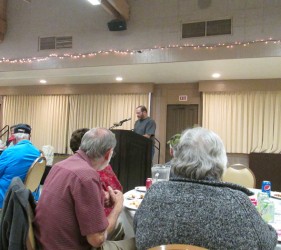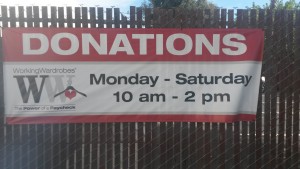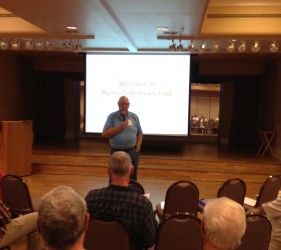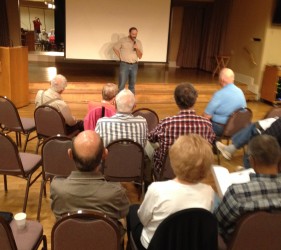On Monday, February 15, 2016, Mr. Bruce Hunt invited Tender Touch Ministries to speak to veterans at the VFW POST #6024, in Mission Viejo CA.
We shared information about our veterans openARMs Program and how our unique approach is making a “Real Difference” in the community!
After the presentation, each veteran received a “gift basket“, as a small token of appreciation for their service. Special thanks to Arlene Pfeifer for creating our openARMs veterans gift baskets. Great job!
 For over forty years, the goal at Veterans First has been to honor every brave man and woman who has served this country by helping restore dignity to those whose sacrifices defending the freedoms we cherish have left them in need.
For over forty years, the goal at Veterans First has been to honor every brave man and woman who has served this country by helping restore dignity to those whose sacrifices defending the freedoms we cherish have left them in need.
Veterans First provides housing and essential services for Orange County’s homeless and at-risk veterans as well as services for families of at-risk vets and deployed military members.
Veterans First currently operates 10 permanent and transitional housing facilities at a capacity of 122 total beds for employable and disabled veterans within 3 Northern Orange County cities (Anaheim, Garden Grove and Santa Ana). Each home is staffed 24/7 with a house manager that can assist our clients with making sure that they are working towards a successful completion of our program. Each house is also staffed with a cook that provides nutritious meals to our clients. Additionally, Veterans First in the summer of 2011 began operating the county’s only transitional housing facility for unaccompanied homeless female veterans.
 Tender Touch Ministries is pleased to announce a partnership with Working Wardrobes, an Orange County-based non-profit organization that empowers men, women, veterans and young adults in overcoming difficult challenges to confidently enter the workforce and achieve self-sufficiency. They provide career assessments, skills training, career development services, job placement assistance and professional wardrobes in an environment of dignity and respect.
Tender Touch Ministries is pleased to announce a partnership with Working Wardrobes, an Orange County-based non-profit organization that empowers men, women, veterans and young adults in overcoming difficult challenges to confidently enter the workforce and achieve self-sufficiency. They provide career assessments, skills training, career development services, job placement assistance and professional wardrobes in an environment of dignity and respect.
Working Wardrobes has been serving the community since 1990.
Tender Touch Ministries will act as a facilitator by incorporating many of Working Wardrobes’ services into their homeless advocacy framework.
 Tender Touch Ministries is pleased to announce the openARMs Program to assist Orange County Armed Services Veterans in need. This initiative will provide immediate assistance to veterans who are homeless and struggling, as well as help them locate short and long-term care that’s available from a wide network of providers. Connecting veterans to disability services, including counseling for post traumatic stress disorder, as well as resources for jobs and education are all included in the openARMs Program.
Tender Touch Ministries is pleased to announce the openARMs Program to assist Orange County Armed Services Veterans in need. This initiative will provide immediate assistance to veterans who are homeless and struggling, as well as help them locate short and long-term care that’s available from a wide network of providers. Connecting veterans to disability services, including counseling for post traumatic stress disorder, as well as resources for jobs and education are all included in the openARMs Program.
The official tagline of the program is “Embracing Our Honored Heroes In Need.” This specifically speaks to the tragic reality that many veterans come home from war post 9/11 with nowhere to go. Tender Touch Ministries is reaching out to these veterans directly in the streets, providing “Welcome Home” Packages with necessities as well as further assistance in contacting available resources.
For more on the openARMs Program and how you can get involved, click here.
Last week, the Orange County Community Foundation (OCCF) issued a compelling report demonstrating military veterans coming home to Orange County have powerful obstacles when adjusting to civilian life. In the worst cases, returning veterans faced great challenges in securing adequate employment, finding stable housing and meeting physical and mental health needs. OCCF unveiled the report to 250 donors and business and community leaders, preceded by an address from Admiral Mike Mullen, 17th Chairman of the Joint Chiefs of Staff and 28th Chief of Naval Operations.
Sixty-one percent of post-9/11 veterans report adjustment challenges; compared to 30 percent of pre-9/11 veterans.
View the full report here: oc-cf.org/veterans
—–
Tender Touch Ministries currently offers Veterans assistance through the openARMs Program.
Please visit this link for how you can assist.
The Fe bruary 2015 Issue of National Geographic features a cover story, “The Invisible War on the Brain,” on soldiers returning home from Iraq and Afghanistan with incredible challenges, not the least of which is the mysterious and devastating effects of traumatic brain injuries from the force of nearby blasts.
bruary 2015 Issue of National Geographic features a cover story, “The Invisible War on the Brain,” on soldiers returning home from Iraq and Afghanistan with incredible challenges, not the least of which is the mysterious and devastating effects of traumatic brain injuries from the force of nearby blasts.
While the evidence for brain injury is very real, veterans are often challenged in their ability to describe the psychological effects, which include confusion, anger and depression, but in ways that defy words. In an effort to promote healing and communication, some soldiers have tried a program that encourages them to paint masks where words cannot articulate the pain.
The article, written by Caroline Alexander, goes on to explain the main problem with diagnosing and treating the blast force injuries, “Despite the prevalence of the condition, the most fundamental questions about it remain unanswered. Not only is there no secure means of diagnosis, but there are also no known ways to prevent it and no cure. Above all, there is no consensus within the medical community about the nature of blast-induced injury or by what mechanism blast force damages the brain.”
Meanwhile, Tender Touch Ministries is currently assisting Orange County, CA veterans of all ages with transitioning back into civilian life, including connecting them to resources to help with medical and psychological needs via the openARMs Program.
Links:
http://ngm.nationalgeographic.com/
https://www.tendertouchministries.org/openarms-program/
Citations:
Alexander, C. (2015, February 1). The Invisible War on the Brain. National Geographic, 35.













